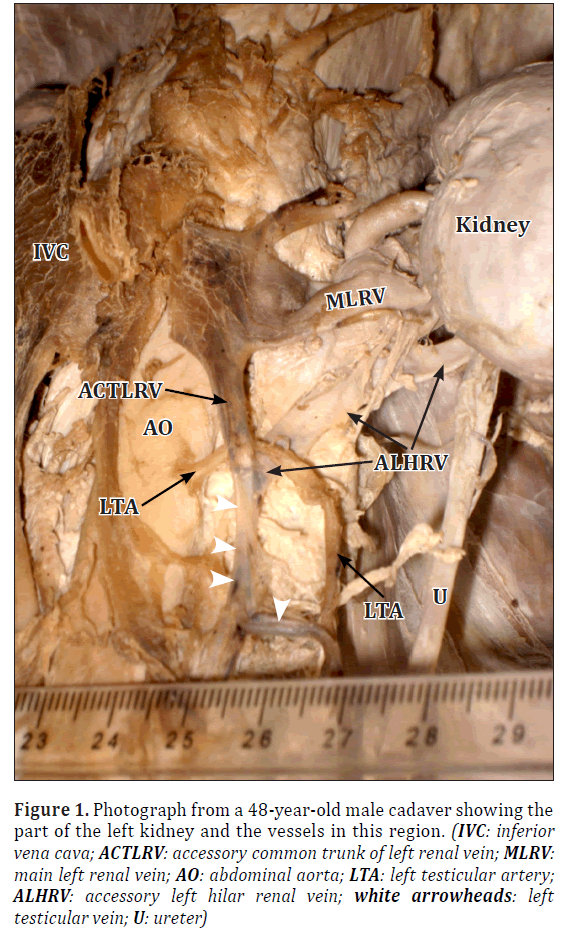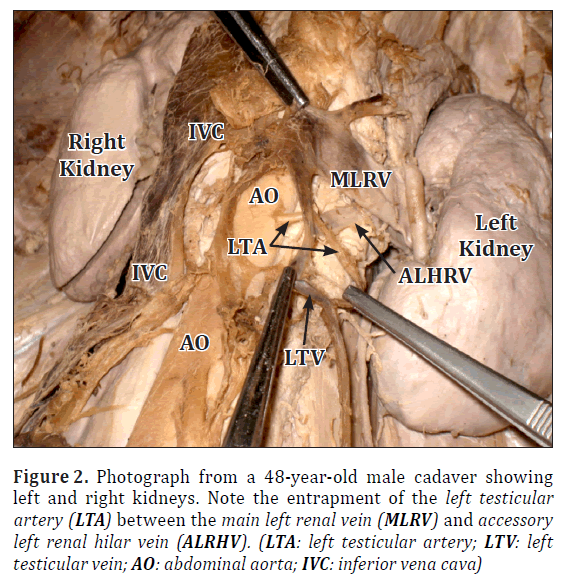Looped left testicular artery in relation to a variant left renal vein: a case report
2 Department of Surgery and Maternal Health, School of Medicine, College of Health Sciences, The University of Dodoma, Dodoma, Tanzania
3 Department of Anatomy and Histology, School of Medicine, International Medical and Technology University, Dar es Salaam, Tanzania
4 Department of Biomedical Sciences, School of Medicine, The University of Dodoma, Tanzania
Received: 26-Feb-2013 Accepted Date: Oct 27, 2013; Published: 12-Jun-2014
Citation: © Int J Anat Var (IJAV). 2014; 7: 57–59.
This open-access article is distributed under the terms of the Creative Commons Attribution Non-Commercial License (CC BY-NC) (http://creativecommons.org/licenses/by-nc/4.0/), which permits reuse, distribution and reproduction of the article, provided that the original work is properly cited and the reuse is restricted to noncommercial purposes. For commercial reuse, contact reprints@pulsus.com
Abstract
Variations involving the renal and testicular vessels are not uncommon. During a routine dissection of a 48-year-old male cadaver, one main and one accessory hilar renal vein were observed in the left kidney. The accessory hilar renal vein received the left testicular vein before it entered the main left renal vein. We also discovered for the first time the entrapment of the arched left testicular artery between the main renal vein and accessory hilar renal veins. The knowledge of these anatomical variations is important to radiologists in interpreting renal and testicular angiograms and to surgeons performing interventional procedures on a patient with these variations.
Keywords
testicular artery, hilar and main renal vein, variation, compression
Introduction
The kidneys and gonads (testicles) are supplied by renal and testicular arteries (TAs) and drained by the respective veins. Testicular arteries normally originate from the abdominal aorta, just below the level of renal arteries [1]. Left renal vein is a tributary of inferior vena cava (IVC) and normally receives the left gonadal (testicular) vein before it empties into IVC. Different variations involving the testicular arteries and renal veins are well documented and have been reported by many researchers [1-8]. In the present case we are reporting a clinically, surgically and radiologically important variation involving the left testicular artery and left renal venous drainage.
Case Report
During routine dissection classes for undergraduate medical students, we observed variations in a 48-year-old male cadaver involving the blood supply to the left testis and venous drainage of the left kidney. The left kidney contained supernumerary renal veins in addition to the normal left renal vein. It showed an accessory left hilar renal vein (ALHRV) that originated from the hilum of the left kidney just posterior to the main left renal vein (Figure 1). It coursed inferiorly and medially to receive the left testicular vein (LTV) to form an accessory common left renal venous trunk (ACLRVT), which emptied into the main left renal vein (MLRV). At this point of union, the ALHRV was overridden by the arch of the left testicular artery (LTA), which lied between the ALHRV and the common trunk that travelled for about 1.4 cm to open into MLRV (Figure 1), 2.1 cm from the IVC. The ALHRV measured 3.4 cm in length from the renal hilum to the point where it joins with LTV. The MLRV measured 7.2 cm long from the renal hilum to the IVC.
Figure 1: Photograph from a 48-year-old male cadaver showing the part of the left kidney and the vessels in this region. (IVC: inferior vena cava; ACTLRV: accessory common trunk of left renal vein; MLRV: main left renal vein; AO: abdominal aorta; LTA: left testicular artery; ALHRV: accessory left hilar renal vein; white arrowheads: left testicular vein; U: ureter)
On the same cadaver, the left testicular artery (LTA) originated from the anterolateral part of the abdominal aorta, 1 cm above the origin of the right testicular artery and 2.6 cm below the origin of the left renal artery and ascended upwards passing between the ACLRVT formed by the union of the ALHRV and the LTV superficially and the ALHRV inferiorly. At the point where the ALHRV joined LTV, the LTA looped and turned downward and descended to supply the left testis within the common cord with left testicular vein (Figure 2).
Figure 2: Photograph from a 48-year-old male cadaver showing left and right kidneys. Note the entrapment of the left testicular artery (LTA) between the main left renal vein (MLRV) and accessory left renal hilar vein (ALRHV). (LTA: left testicular artery; LTV: left testicular vein; AO: abdominal aorta; IVC: inferior vena cava)
However, such variations were not observed on the opposite side of the same cadaver and there was no important finding with regard to the testes.
Discussion
In normal anatomy the left kidney is drained by the left renal vein (LRV) which receives the LTV as its direct tributary. LRV is a tributary of IVC. Variations of renal veins are rare compared to the renal arteries [1] and they are more common on the right renal vein than the left renal vein [4]. Left renal venous drainage variations that have been described include branching of the left renal vein [6], circumaortic venous ring and retro-aortic bifid left renal vein [9]. The present observation has showed the presence of ALHRV in addition to the MLRV. We named it as accessory hilar renal vein because it was located on the left renal hillum on the same location just posterior to the origin of MLRV. In addition to this, the ALHRV united with the LTV to form an ACLRVT, which emptied into the MLRV. The LTA did not show a direct course, it formed a loop that arched between the ALHRV and ACLRVT. These observations have medical implications and this phenomenon is linked to the embryological development variations that may be due to failure of the fusion of the segmental renal vein to form a single left renal vein or failure in complete division of the left renal vein as reported by Malcic-Gurbuz et al., [6]. Interestingly, the ALHRV on its way it joined the LTV at the point where the LTA looped over to descend down to supply the left testis. The understanding of this anatomical variation of the LTV joining the ALHRV instead of MLRV is important during surgical procedures involving the hilum of the kidney but also necessary in interpretation of radiological images of this anatomical area.
The anatomical variations involving TAs are common and have been reported by several researchers. Common variations encountered in relation to TA involve level of origin, accessory or aberrant gonadal artery and unusual course of artery like arching anterior to renal vein [2,7]. According to Machnicki classification there are four major types of testicular arteries classified based on their origin from the aorta or renal artery: Type A –a single TA originating from the aorta; Type B –a single TA originating from the renal artery; Type C –two TAs originating from the aorta supplying the same gonad; Type D –two TAs supplying the same gonad, one arising from aorta and other from the renal artery [5]. Another classification by Notkovich describes the TA in relation to the renal vein as three types: Type I –TA arising from the aorta, passing posterior or inferior to the renal vein but without making contact with it; Type II –TA originating from the aorta, superior to the renal vein and crossing in front of it; and Type III –TA arising from the aorta and passing posterior or inferior to the renal vein and coursing superiorly and around the renal vein [8]. Our case report is Type A of TA according to Machnicki classification and Type III of TA according to Notkovich classification, which is also termed as arched testicular artery [7]. Also, it has been reported by Mamatha et al., that the LTA originated from the abdominal aorta at level of origin of renal artery and posterior to renal vein, then ascended upwards and arched over left renal vein and coursed downwards to supply the testis [7] but in our case the LTA arose from the anterolateral part of the abdominal aorta, 1 cm above the origin of the right testicular artery and 2.6 cm below the origin of the left renal artery and ascended upwards and arched inferior to the MLRV but above the ALHRV. This variations are believed to be attributed to their embryologic derivation [3] and the entrapment of the LTA between the two divisions of left renal vein (MLRV and ALHRV) is a novel finding and is clinically and surgically important since it could result in compression of the vessels causing testicular and pelvic varicocele and can also be injured during abdominal surgery, hence this report raise the awareness for surgeons on the possibilities of cutting a vessel during routine procedures.
Conclusion
Understanding the anatomical variation of the LTV to join the ALHRV instead of MLRV is important during surgical procedures involving the hilum of the kidney but also necessary in interpretation of images of this anatomical area. Also the entrapment of the LTA between the two divisions of left renal vein is a novel finding and is clinically and surgically important since it could result in compression of the vessels causing testicular and pelvic varicocele.
Acknowledgements
We thank Prof. Y. Satoh (Iwate Medical University) for his moral support and all members of Cell Biology and Neuroanatomy for their encouragement.
REFERENCES
- Satheesha NB. Abnormal course of left testicular artery in relation to an abnormal left renal vein: A case report. Kathmandu Univ Med J (KUMJ). 2007; 5: 108–109.
- Cicekcibasi AE, Salbacak A, Seker M, Ziylan T, Buyukmumcu M, Uysal II. The origin of gonadal arteries in human fetuses: anatomical variations. Ann Anat. 2002; 184: 275–279.
- Paraskevas GK, Ioannidis O, Raikos A, Papaziogas B, Natsis K, Spyridakis I, Kitsoulis P. High origin of testicular artery: a case report and review of the literature. J Med Case Rep. 2011; 5: 75.
- Janschek EC, Rothe AU, Holzenbein TJ, Langer F, Brugger PC, Pokorny H, Domenig CM, Rasoul-Rockenschaub S, Muhlbacher F. Anatomic basis of right renal vein extension for cadaveric kidney transplantation. Urology. 2004; 63: 660–664.
- Machnicki A, Grzybiak M. Variations in testicular arteries in fetuses and adults. Folia Morphol (Warsz) 1997; 56: 277–285.
- Malcic-Gurbuz J, Akalin A, Gumuscu B, Cavdar S. Clinical implications of concomitant variations of the testicular, suprarenal and renal veins: a case report. Ann Anat. 2002; 184: 35–39.
- Mamatha Y, Prakash BS, Latha PK, Ramesh BR. Variant course of left gonadal artery. Int J Anat Var (IJAV). 2010; 3: 132–133.
- Notkovich H. Variations of the testicular and ovarian arteries in relation to the renal pedicle. Surg Gynecol Obstet. 1956; 103: 487–495.
- Senecail B, Bobeuf J, Forlodou P, Nonent M. Two rare anomalies of the left renal vein. Surg Radiol Anat. 2003; 25: 465–467.








